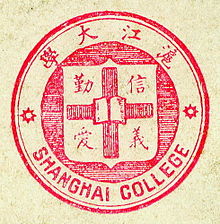Hujiang University
This article needs additional citations for verification. (June 2019) |
滬江 | |
 | |
Other name | Shanghai College University of Shanghai |
|---|---|
| Motto | |
| Type | Private university |
| Active | 1906–1952 |
| Affiliation | Baptist |
| President | Liu Zhan'en |
| Location | , China |
Hujiang University (simplified Chinese: 沪江
History[edit]
During the Boxer Rebellion in 1900, the Central China Mission of the American Southern Baptist Convention and the East China Mission of the American Baptist Missionary Union (Northern Baptists) gathered in Shanghai. The two missions collaborated for higher education, establishing the Shanghai Baptist Theological Seminary in 1906 and Shanghai Baptist College in 1909. The two were combined in 1911 to form "Shanghai Baptist College and Theological Seminary" (
Liu Zhan'en (or Herman Chan-En Liu), an alumnus of Teachers College, Columbia University, was the first Chinese president to succeed Dr. F. J. White as university president.[2]
Hujiang University was in a critical position for information sharing after the 1937 Battle of Nanking. President Liu was assassinated by the Japanese military at a bus stop in Shanghai on April 7, 1938, after he secretly disseminated Nanjing Massacre photos (taken by Western missionaries) to people around the world.[3][4]
Ling, Hsien-yang (prefers Henry H. Lin), an alumnus of Hujiang University (1927) and University of Southern California (1929), was the last Chinese president of the university. He elected to remain in mainland China to take care of the university and its students following the communist takeover of China in 1949. He was imprisoned in 1951 as part of the Campaign to Suppress Counterrevolutionaries and died few years later.[5]
In 1952[edit]
Hujiang University was merged into East China Normal University and other universities in Shanghai. It is no longer existing. Some university records are available for research purposes in Yale University Divinity School's Library.
Building[edit]
In 1919, the campus was designed by the American architect Henry Murphy's company.[6]
References[edit]
- ^ China and the Christian colleges 1850-1950, Jessie Gregory Lutz, Cornell University Press, 1971 Page 575
- ^ Herman Chan-En Liu (1922). Non-verbal Intelligence Tests for Use in China (Thesis). Teachers College, Columbia University.
- ^ "Liu Zhan'en: L: By Person: Stories: Biographical Dictionary of Chinese Christianity". www.bdcconline.net. Archived from the original on 2016-10-31. Retrieved 2016-10-31.
- ^ https://wjk.usst.edu.cn/_upload/article/files/d5/0c/7602e9b84effb5484e344c40aa7c/432b0975-4e80-474d-bf51-56c95707f452.pdf [bare URL PDF]
- ^ Ling, Hsien-yang, Chinese Who's Who, China Year Book 1947, p. 674.
- ^ "
海 派 城市 考古 |美 籍 校 园建筑设计师亨 利 ·墨 菲的在 沪印迹" [en:Shanghai Urban Archaeology|The Marks of American Campus Architect Henry Murphy in Shanghai]. zh:澎湃 新 闻. 2023-08-21. Retrieved 2024-03-18.zh:
亨 利 ·墨 菲(Henry K. Murphy)是 20世 纪上半 叶 中国 建 筑古典 复兴思潮 的 代表 性 人物 ,以"适应性 建 筑"理念 深深 地 影 响了中国 第 一 代 建 筑师,并且成 为"重 塑民国 时期大 学校 园的设计师"。墨 菲以校 园和校舍 设计闻名于中国 ,主 导了当 时许多 知名 大学 的 建 设,例 如清华大学 、复旦大学 、金 陵 女子 大学 等 。
